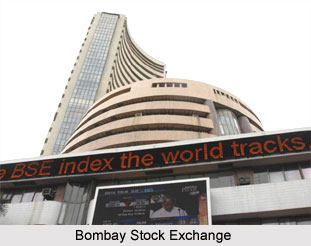 Bombay Stock Exchange Limited (previously known as The Stock Exchange, Mumbai and generally called The Bombay Stock Exchange, or BSE) is the oldest stock exchange in Asia. It is situated at Dalal Street in the city of Mumbai in India.
Bombay Stock Exchange Limited (previously known as The Stock Exchange, Mumbai and generally called The Bombay Stock Exchange, or BSE) is the oldest stock exchange in Asia. It is situated at Dalal Street in the city of Mumbai in India.
The Bombay Stock Exchange was set up in 1875. Over the past 137 years, Bombay Stock Exchange has facilitated the growth and expansion of the Indian corporate sector by providing it an efficient capital-raising platform. This institution was established as "The Native Share & Stock Brokers` Association" in 1875.
Bombay Stock Exchange is a corporative body, with a broad shareholder-base. This includes leading worldwide exchanges, Deutsche Bourse and Singapore Exchange as strategic partners. BSE provides a well-organized and clear market for trading in equity, debt instruments, derivatives, mutual funds. It also has a platform for trading in equities of small-and-medium enterprises. There are around 5000 companies are listed on BSE making it world`s No. 1 exchange in terms of listed members. The companies listed on BSE Ltd command a total market capitalization of USD Trillion 1.06 as of May 15, 2012. BSE Ltd is world`s fifth most active exchange in terms of number of transactions handled through its electronic trading system. This stock exchange is also one of the world`s leading exchanges for Index options trading. BSE is the fifth largest in the world.
BSE also provides a congregation of other services to capital market participants. This includes risk management, clearing, settlement, market data services and education. It has a global reach with customers around the world and a nation-wide presence. BSE systems and processes are designed to safeguard market integrity, drive the growth of the Indian capital market and stimulate innovation and competition across all market segments. BSE is the first exchange in India and second in the world to obtain an ISO 9001:2000 certification. It is also the first exchange in the country and second in the world to receive Information Security Management System Standard BS 7799-2-2002 certification for its On-Line trading System (BOLT).
It operates one of the most respected capital market educational institutes in the country (the BSE Institute Ltd.). BSE also provides depository services through its Central Depository Services Ltd. (CDSL) arm.
BSE`s popular equity index - the SENSEX - is India`s most widely tracked stock market benchmark index. It is traded internationally on the EUREX as well as leading exchanges of the BRCS nations (Brazil, Russia, China and South Africa).
The Bombay Stock Exchange SENSEX (also known as the BSE 30 index) is a value-weighted parameter composed of a total of thirty scripts, with the base figuring April 1979 = 100. The group of companies that constitute the index has been changed only a few times in the last twenty years. These companies make up around one-fifth of the market capitalization of the BSE.
Apart from the BSE SENSEX, which is the most accepted stock index in India, BSE uses other stock indicators as well. These are BSE 500, BSE 100, BSE 200, BSE PSU, BSE MIDCAP, BSE SMLCAP, BSE BANKEX, BSE Teck, BSE Auto, BSE Pharma, BSE Fast Moving Consumer Goods, BSE Metal, BSE Metal and BSE Broadcast. The BSE Broadcast is a large timepiece on the wall of the BSE, which constantly exhibits the most recent stock quotes from the market. It is also displayed on one of the foremost business-news channels in India -- NDTV Profit.
Dr Prannoy Roy, the Managing Director of New Delhi Television (NDTV) Ltd, made the new scheme that is airing the updated news on business to the people of India from December 15, 2006. Mr Damodaran, the Chairman of the Securities and Exchange Board of India (SEBI), said that the ticker would offer information and analysis of the happenings of the financial world.



















